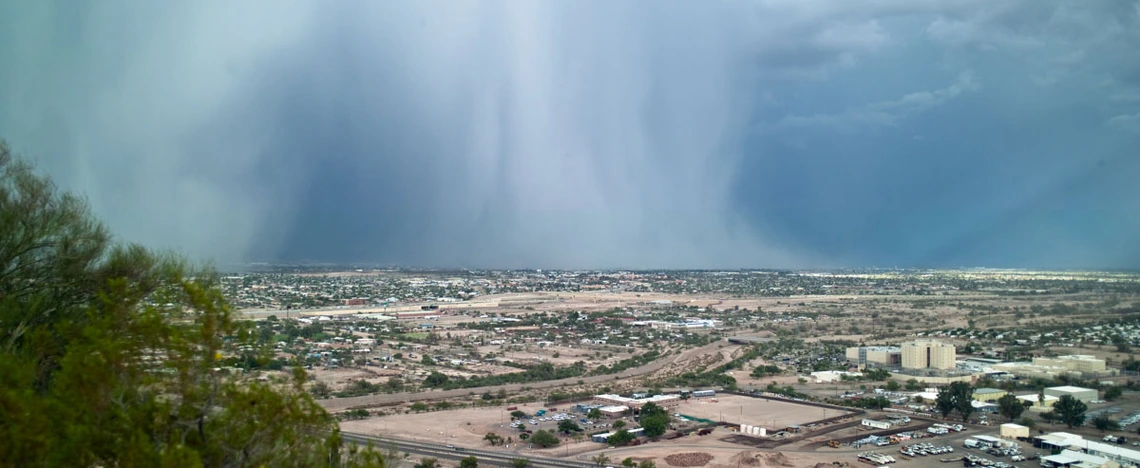Guest View - Tracking the summer monsoon

By Mike Crimmins, Extension Specialist in Climate Science and Professor, Soil/Water and Environmental Science
The summer monsoon season is upon us again! The sun is high in the sky, temperatures have climbed to their highest levels of the year and the cicadas are buzzing. We wait in great anticipation now for the first signs of monsoon moisture creeping in from the south. The official monsoon season start date defined by the NOAA National Weather Service is June 15th, but it usually takes a couple of weeks after this date for the deep and consistent monsoon moisture to settle in across southern Arizona. In the past the NOAA-NWS in Tucson used a monsoon start date definition based on daily average dewpoint temperatures (dewpoint temperature is a measure of the amount of moisture in the atmosphere with higher values indicating more moisture). The first three days in a row that had daily average dewpoints higher than 54 degrees F would signal the start of the monsoon season. Historically this happens on average around July 3rd. Based on data back to 1949 for Tucson, 93% of monsoon starts have occurred in a two week window from Jun 24th to July 9th around this July 3rd average. The earliest on record was June 17th in 2000 and latest on July 25th in 1987 (all of the statistics can be found here). Based on these historical statistics there is a good chance that we will see the monsoon moisture settle in across Tucson in the next couple of weeks (July 8th was the start date in 2018 based on the dewpoint definition).
Monsoon moisture doesn’t guarantee rainfall in your backyard though. Monsoon thunderstorms are notorious for producing highly localized and often extreme amounts of precipitation. This means that even in a neighborhood some people can observe inches of rain while down the street the pavement is dry. There are some handy online tools though to keep tabs on monsoon precipitation and the evolution of monsoon season weather. Some specific ones that focus on Arizona in particular include:
This site hosts an online, volunteer rainfall monitoring network active across Arizona and a couple of other Western U.S. states. There are over 300 active observers in the Tucson area alone which can capture the very fine scale patterns of thunderstorms during the monsoon season. Anyone can register a gauge, contribute data and enjoy being able to taunt your neighbors with how much more rain you received than they did.
The Tucson National Weather Service Office hosts the official Southwest U.S. monsoon season tracking page with lots of historical information, current precipitation totals, educational materials on how the monsoon works and technical meteorological information for the serious weather enthusiast.
The Climate Assessment for the Southwest at the University of Arizona produces a monthly climate summary and outlook for Arizona and New Mexico that details recent climate conditions and outlooks for the Southwest region. There is a special monsoon season tracker in the SWCO during the summer months. Also check out the companion Southwest Climate Podcast that discusses the content of the SWCO in greater depth.
Most of the county flood control districts across Arizona operate their own rain gauge networks that provide real-time precipitation and streamflow monitoring. The Arizona Flood Warning System page pulls all of these data together into one very easy to use website. You can see precipitation events evolve in real time and also access totals back through the past two weeks.
If you are interested in seeing how precipitation patterns are evolving through the monsoon season across the whole region, check out this precipitation mapping tool. This site uses gridded precipitation estimates (4km grid produced by the OSU PRISM Climate Group) to track total precipitation from June 15th through September 30th across Arizona and New Mexico. Several other metrics including percent of average, number of rain days, and maximum precipitation amounts are also available in near-real time. You can also explore past monsoon seasons back through 1981.
These are just a handful of resources with many additional ones available through links on each of these sites. Climatology, again, suggests that the start is right around the corner. We will have to wait and see how the precipitation patterns stack up across the region through the season. Hopefully, though, we won’t have to wait too long to be treated to the amazing lightning shows and cooling, life giving rains that the monsoon season brings to the Southwest U.S.

